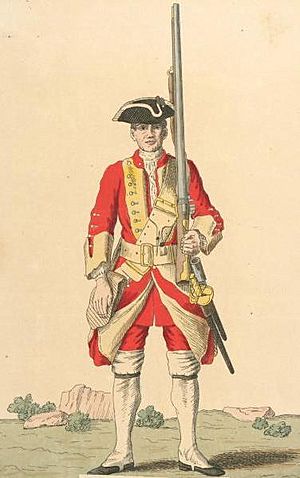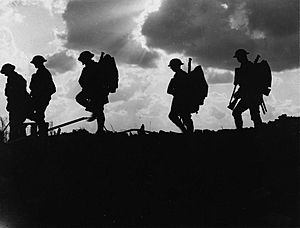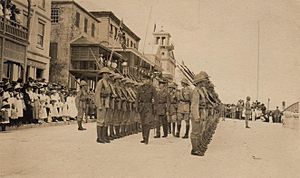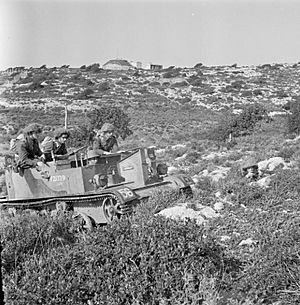East Yorkshire Regiment facts for kids
Quick facts for kids East Yorkshire Regiment (The Duke of York's Own) |
|
|---|---|
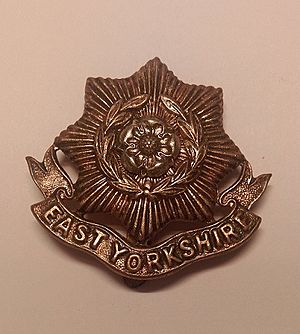
Cap badge
|
|
| Active | 1685–1958 |
| Country | |
| Branch | |
| Type | Line infantry |
| Role | Infantry |
| Size | 1–2 Regular battalions 1 Militia Battalion 2 Territorial battalions Up to 16 Hostilities-only battalions |
| RHQ | Victoria Barracks, Beverley |
| Nickname(s) | The Snappers |
| Anniversaries | Quebec (13 September) |
The East Yorkshire Regiment was a famous British Army regiment that served for almost 300 years. It started in 1685 as Sir William Clifton's Regiment of Foot. Later, it was known as the 15th Regiment of Foot.
This regiment took part in many important events throughout history. It fought in major wars around the world. In 1958, it joined with the West Yorkshire Regiment. Together, they formed the Prince of Wales's Own Regiment of Yorkshire. Later, in 2006, this regiment became part of the larger Yorkshire Regiment.
Contents
- The East Yorkshire Regiment: A Brave History
- The Regimental Museum
- The Snappers: A Special Nickname
- Brave Actions: Battle Honours
- Heroes of the Regiment: Victoria Cross Winners
The East Yorkshire Regiment: A Brave History
Early Adventures: From 1685 to the 1700s
The regiment began in 1685 in Nottingham, England. It was first named after its leader, Sir William Clifton. This was a common practice for regiments back then.
The soldiers quickly saw action in Scotland. They fought in battles like Killiecrankie and Cromdale. These were part of the Jacobite uprisings.
In 1694, the regiment went to Flanders (modern-day Belgium). They helped capture Huy and Namur during the Nine Years' War. They returned home in 1697.
Fighting in Europe and America
The regiment was sent to Holland in 1701. They fought in the War of the Spanish Succession. They were part of big battles like Blenheim in 1704. They also fought at Ramillies, Oudenarde, and Malplaquet. These were huge battles in European history.
After returning to England, they went to Scotland again. They helped in the Battle of Glen Shiel in 1719. Then, they traveled far to South America. They fought in the Battle of Cartagena de Indias in 1741.
In 1746, they were back in Scotland for another Jacobite uprising. They fought at the Battle of Culloden. In 1751, the regiment got its number: the 15th Regiment of Foot.
They helped capture Île-d'Aix in 1757. Then, they sailed to North America in 1758. They fought in the famous Battle of the Plains of Abraham in 1759. This was during the Seven Years' War. In 1782, they became the 15th (The Yorkshire East Riding) Regiment of Foot.
The regiment returned to North America in 1776. They fought in the American Revolutionary War. They took part in battles like Long Island and Brandywine.
The Napoleonic Wars and Victorian Era
In 1795, the regiment went to the West Indies. They fought against French forces there. They attacked Martinique and Guadeloupe. They returned to England in 1796.
They went back to the West Indies in 1805. This was during the Napoleonic Wars. They helped invade Martinique in 1809 and Guadeloupe in 1810.
Protecting the British Empire
For most of the 1800s, the regiment served as guards. They were stationed in Britain and across the British Empire. In 1862, the 1st Battalion went to New Brunswick, Canada. This was during a tense time with the United States.
In 1881, the regiment officially became The East Yorkshire Regiment. The 1st Battalion traveled a lot. They were in Gibraltar, the West Indies, South Africa, and Egypt. From 1895, they served in British India.
The 2nd Battalion was in British India from 1875. They fought in the Second Anglo-Afghan War. In 1900, they were sent to South Africa. They helped fight in the Second Boer War. About 870 soldiers sailed there. They stayed until the war ended in 1902.
The 3rd Battalion was a reserve unit. It was made up of local volunteers. They also served in South Africa during the Boer War. In 1908, the army changed how it organized reserve forces. The regiment then had one reserve and two volunteer battalions.
The First World War: A Global Conflict
Regular Soldiers and Local Heroes
The 1st Battalion arrived in France in September 1914. They fought on the Western Front. The 2nd Battalion also landed in France in January 1915. They later moved to Greece to fight on the Macedonian front.
Many local battalions were formed. The 1/4th Battalion fought on the Western Front from April 1915. The 2/4th Battalion served in Bermuda. The 5th (Cyclist) Battalion guarded the coast in Britain.
New battalions were also created for the war. The 6th (Service) Battalion went to Gallipoli in 1915. They were later moved to the Western Front. The 7th and 8th (Service) Battalions also fought on the Western Front.
Four special battalions were formed from volunteers in Hull. They were known as the "Hull Pals." These included the 'Hull Commercials' and 'Hull Sportsmen.' They fought in Egypt and then on the Western Front.
Between the Big Wars
In 1935, the regiment received a special honor. It was renamed The East Yorkshire Regiment (The Duke of York's Own). This was after its Colonel-in-Chief, the Duke of York.
The Second World War: Facing New Challenges
From France to the Jungles of Burma
The 1st Battalion was in British India when the war started in 1939. They didn't see action until 1942. In 1944, they trained for jungle warfare in India. They then moved into Burma in 1945. They helped break the siege of Meiktila.
The 2nd Battalion served with the 3rd Infantry Division. This division was led by Major-General Bernard Montgomery. They went to France in 1939 as part of the British Expeditionary Force. They fought in the Battle of France. They were evacuated from Dunkirk in 1940.
After Dunkirk, they trained in England for years. They were preparing for a possible German invasion. In 1944, they landed in Normandy, France. They fought through the Normandy campaign.
The 4th Battalion was also in France in 1940. They were evacuated from Dunkirk. They later went to the Middle East. They were captured during the Battle of Gazala.
The 5th Battalion was formed in 1939. They also fought in France and were evacuated from Dunkirk. They later served in North Africa, Tunisia, and Sicily. They landed on Gold Beach on D-Day in 1944. They then fought through Normandy and North West Europe.
Three more battalions were formed during the war. The 6th (Home Defence) Battalion was later disbanded. The 7th Battalion stayed in the UK. The 8th Battalion became an anti-aircraft regiment. They served in North Africa, Italy, and Palestine.
After the Wars: A New Chapter
After the Second World War, the regiment served in Palestine. They then took part in the Malayan Emergency from 1953 to 1956. Later, they were stationed in Germany.
In 1958, the East Yorkshire Regiment joined with the West Yorkshire Regiment. They formed the Prince of Wales's Own Regiment of Yorkshire. This marked the end of the East Yorkshire Regiment as a separate unit.
The Regimental Museum
You can learn more about the regiment at the York Army Museum. It is located at the Tower Street drill hall in York. The museum holds many items from the regiment's history.
The Snappers: A Special Nickname
The East Yorkshire Regiment had a nickname: "The Snappers." This nickname was so well-known that a train was named after them! A locomotive, No. 4780, was called "The Snapper. The East Yorkshire Regiment. The Duke of York's Own."
Brave Actions: Battle Honours
Battle honours are special awards given to regiments. They recognize brave actions in battles. The East Yorkshire Regiment earned many battle honours. These include famous battles like Blenheim, Quebec 1759, and Martinique.
During the First World War, they earned honors for battles like Ypres, Somme, and Arras. In the Second World War, they were recognized for Normandy Landing, El Alamein, and Burma. These honours show the regiment's long history of courage.
Heroes of the Regiment: Victoria Cross Winners
The Victoria Cross (VC) is the highest military award for bravery. Several members of the East Yorkshire Regiment earned this honor:
- Private George William Chafer, for bravery in the First World War.
- Private John Cunningham, for bravery in the First World War.
- Second Lieutenant John Harrison, for bravery in the First World War.
- Sergeant Harold Jackson, for bravery in the First World War.
- Private Eric Anderson, for bravery in the Second World War.


